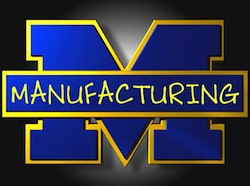Wake Up, Manufacturing, You’re Late
 Did you know that most stuff is manufactured? I didn’t! I thought most stuff springs, fully formed, into packages, and materializes on the shelves of our local dry goods stores.
Did you know that most stuff is manufactured? I didn’t! I thought most stuff springs, fully formed, into packages, and materializes on the shelves of our local dry goods stores.
I kid, I kid. Of course most stuff we consume is manufactured. In fact, a recent University of Michigan study notes that factories produce about 75 percent of what we consume. The warning that follows, though, indicates that as much as 40 percent of that could go overseas (or at least out of the United States) if we make the wrong policy decisions.
I admit, I weary of talk about offshoring and outsourcing. It even makes me feel a little guilty sometimes, that sort of Us versus Them tone it can take. We have, after all, done this to ourselves to a great degree. As high-tech education suffers in the U.S. and gaps in the highly skilled workforce begin to swell, other nations have doubled down on technical education. Hence manufacturing, an increasingly sophisticated, hi-tech field, is suffering a bit in this country.
There are a lot of reasons it’s dwindled in the States, and a lot of reasons it’s sizzling elsewhere. Moreover, there are plenty of reasons why we need to do something about that. At U of M’s Tauber Institute for Global Operations, a sub-entity within Michigan’s Ross School of Business, Wally Hopp and Roman Kapuscinski don’t pull punches.
Hopp and Kapuscinski, contributors to a Tauber/Booz & Co. report called Manufacturing’s Wake-Up Call, freely admit that there are many, complex causes of America’s manufacturing malaise. But they also seem interested in cutting through that, in focusing on solutions over identification of problems, and the one common starting point is education. From K-12 on up, this country’s system has some problems that must be fixed if we hope to regain our global competitive edge.
Another issue they mention is image. “Modern plants are exciting, technical places to work in, but the perception has not caught up with reality,” says Kapuscinski. And how.
If we went out on the street and did an informal poll of what people thought of when they imagined manufacturing, respondents would conjure images of dreary assembly lines, of smokestacks, of ill-educated, coveralled workers glumly turning nuts on bolts. I guess there’s still some of that, but most of the factories I’ve visited recently are gleaming, sterile, computerized Meccas populated by tack-sharp, white-coated facilitators with no grease under their nails and a lot of eagerness to show how cool their jobs can be.
We know if we do nothing, we’re toast. We know that if education isn’t a huge part of the reform effort, we’re not gonna make it. And we also know that we’ve been talking about it, and studying it, for long enough. Now it’s time to do something, or the wake-up call issued by reports such as this will be too little, too late.










